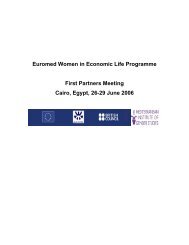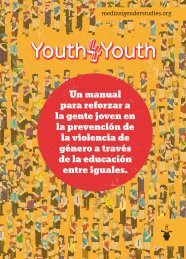react to domestic violence
react to domestic violence
react to domestic violence
Create successful ePaper yourself
Turn your PDF publications into a flip-book with our unique Google optimized e-Paper software.
Building a Support System for Victims of Domestic Violence<br />
not gender aware and often promote and perpetuate gross gender stereotyping and common myths associated<br />
with <strong>violence</strong>. 22 Despite this, it must be acknowledged that in recent years journalists have taken an<br />
increased interest in human rights issues, including issues related <strong>to</strong> women’ rights and <strong>violence</strong> against women.<br />
Research findings by research centres and NGOs are published with more frequency than previously in the<br />
print media and are taken up by TV and radio programmes which have promoted increased awareness and<br />
public debate. Despite this, a lot more needs <strong>to</strong> be done <strong>to</strong> sensitize the media on gender equality issues, as<br />
well as <strong>to</strong> make full use of this medium in reaching a wider audience.<br />
The National Action Plan on the Prevention and Combating Violence in the Family foresees prevention activities<br />
that include the creation of local structures for urgent intervention, the introduction of reconciliation<br />
measures between work and family life, implementation of programmes that provide accessible childcare<br />
services, the creation of counselling centres for young parents, the implementation of awareness raising campaigns,<br />
and educational seminars and lectures. As is the case with other National Action Plans, there is no<br />
timeline specified for the implementation of the actions or specific budget allocated.<br />
There are several concerns in relation <strong>to</strong> the impact of awareness campaigns implemented by government<br />
authorities and women’s organisations/NGOs in Cyprus. Firstly, public awareness initiatives are not implemented<br />
systematically and there is no evidence that initiatives <strong>to</strong> date have had any impact on the wider<br />
society. Furthermore, existing initiatives have focused on informing people of their rights and on encouraging<br />
potential victims and high risk groups <strong>to</strong> report cases of <strong>violence</strong>. Although this is important, it does not<br />
constitute primary prevention as defined above. Another issue in relation <strong>to</strong> the awareness raising campaigns<br />
that have been implemented thus far is that, again, only very generic terminology is used consistent with<br />
the gender-neutral family <strong>violence</strong> framework, and the links between women’s rights, gender equality and<br />
<strong>domestic</strong> <strong>violence</strong> are not addressed. Thus, the question remains as <strong>to</strong> what measures are being taken <strong>to</strong><br />
combat those gender norms, attitudes and behaviours that contribute <strong>to</strong> an environment where <strong>violence</strong> is<br />
<strong>to</strong>lerated and acceptable.<br />
3.3 School Based Initiatives<br />
The education system including schools, teachers’ unions, and Ministries of Education can play a critical role in<br />
addressing <strong>domestic</strong> <strong>violence</strong>. The education system is one of the primary sources of cultural norms, including<br />
those that support gender-based <strong>violence</strong> such as gender stereotyping and the reinforcement of rigid gender<br />
roles of what is supposedly “appropriate” male and female behavior. Because adolescence is a formative<br />
period, such cultural norms can be internalized by young girls and boys, increasing their vulnerability <strong>to</strong> experiencing<br />
<strong>violence</strong> either as victims or as perpetra<strong>to</strong>rs. Emerging evidence suggests that patterns of <strong>violence</strong><br />
and victimization may develop in early adolescence, and soon become difficult <strong>to</strong> reverse. 23 Hence, primary<br />
prevention measures have an essential role in combating <strong>domestic</strong> <strong>violence</strong> since schools and other education<br />
centres are a critical component of adolescents’ lives and one of the main contexts where gender socialization<br />
takes place, as well as where attitudes <strong>to</strong>ward oneself and others are formed and reinforced.<br />
Despite the importance of strategies <strong>to</strong> reach adolescents and young adults in preventing <strong>domestic</strong> <strong>violence</strong>,<br />
this dimension has largely been ignored by those involved in the <strong>domestic</strong> <strong>violence</strong> policy agenda.<br />
Primary prevention has largely been absent from policy and programmes, which focus primarily on adult<br />
victims and their children, crisis response and criminalizing <strong>domestic</strong> <strong>violence</strong>. Thus, existing legislation and<br />
policy measures in place fail <strong>to</strong> target the foundations of this problem in the early stages of its appearance.<br />
22 Who Makes The News (2010) Global Media Moni<strong>to</strong>ring Project 2010, World Association for Christian Communication WACC. Canada.<br />
[http://www.whomakesthenews.org/images/s<strong>to</strong>ries/website/gmmp_reports/2010/global/gmmp_global_report_en.pdf]<br />
23 Rosewater, A. (2003) ‘Promoting Prevention Targeting Teens: An emerging Agenda <strong>to</strong> Reduce Domestic Violence’, Family Violence<br />
Prevention Fund, p. 6.<br />
11







